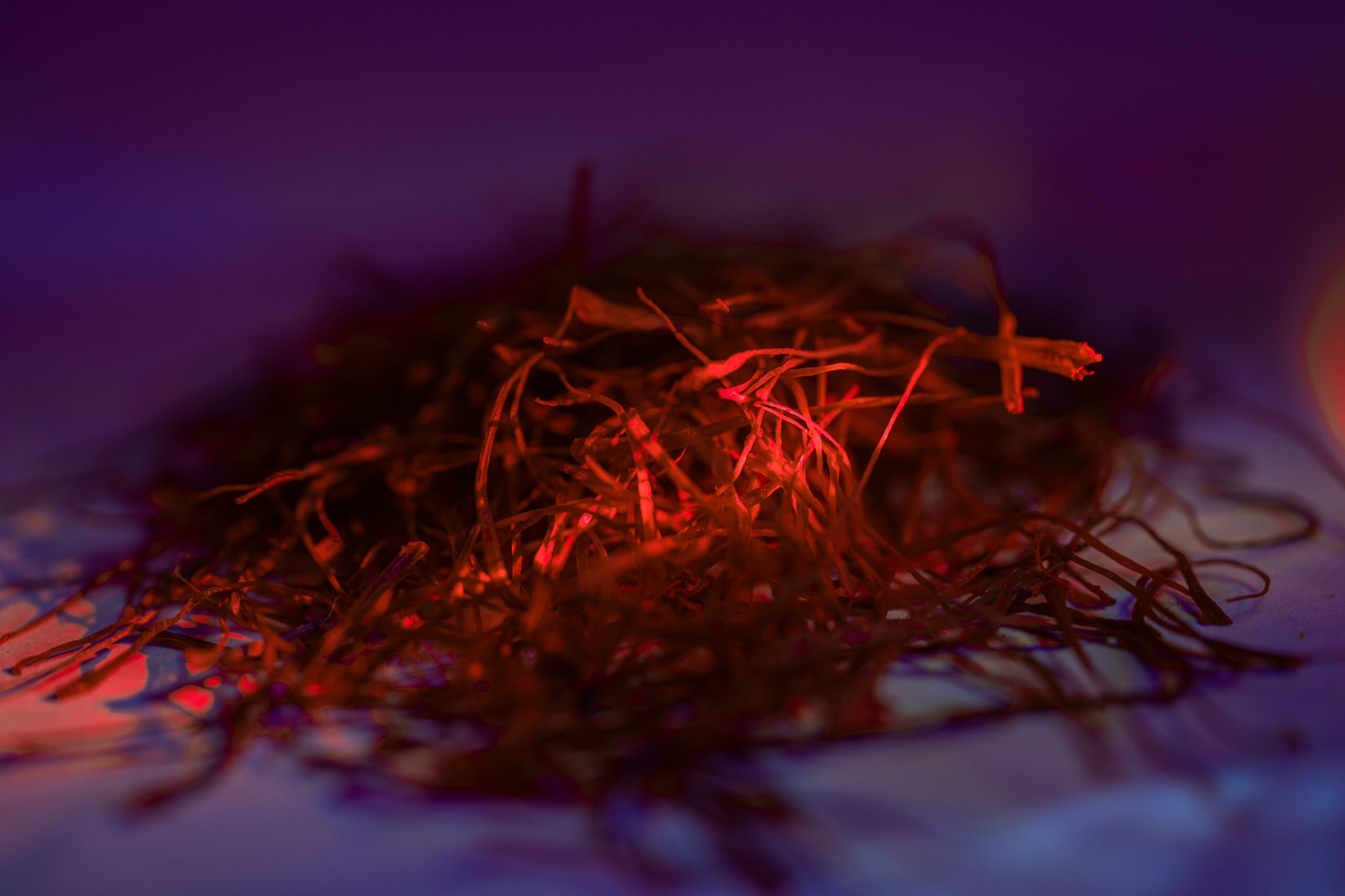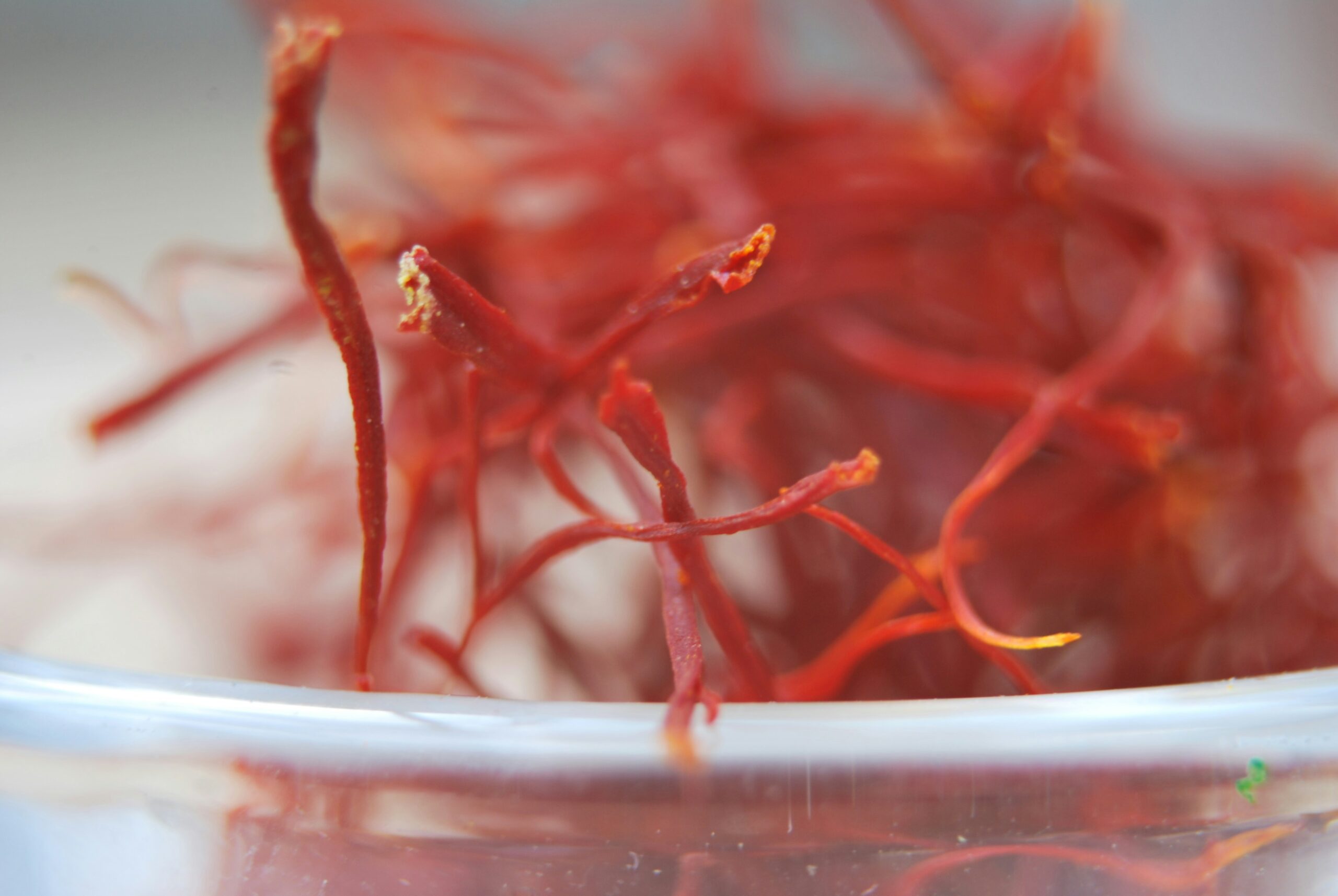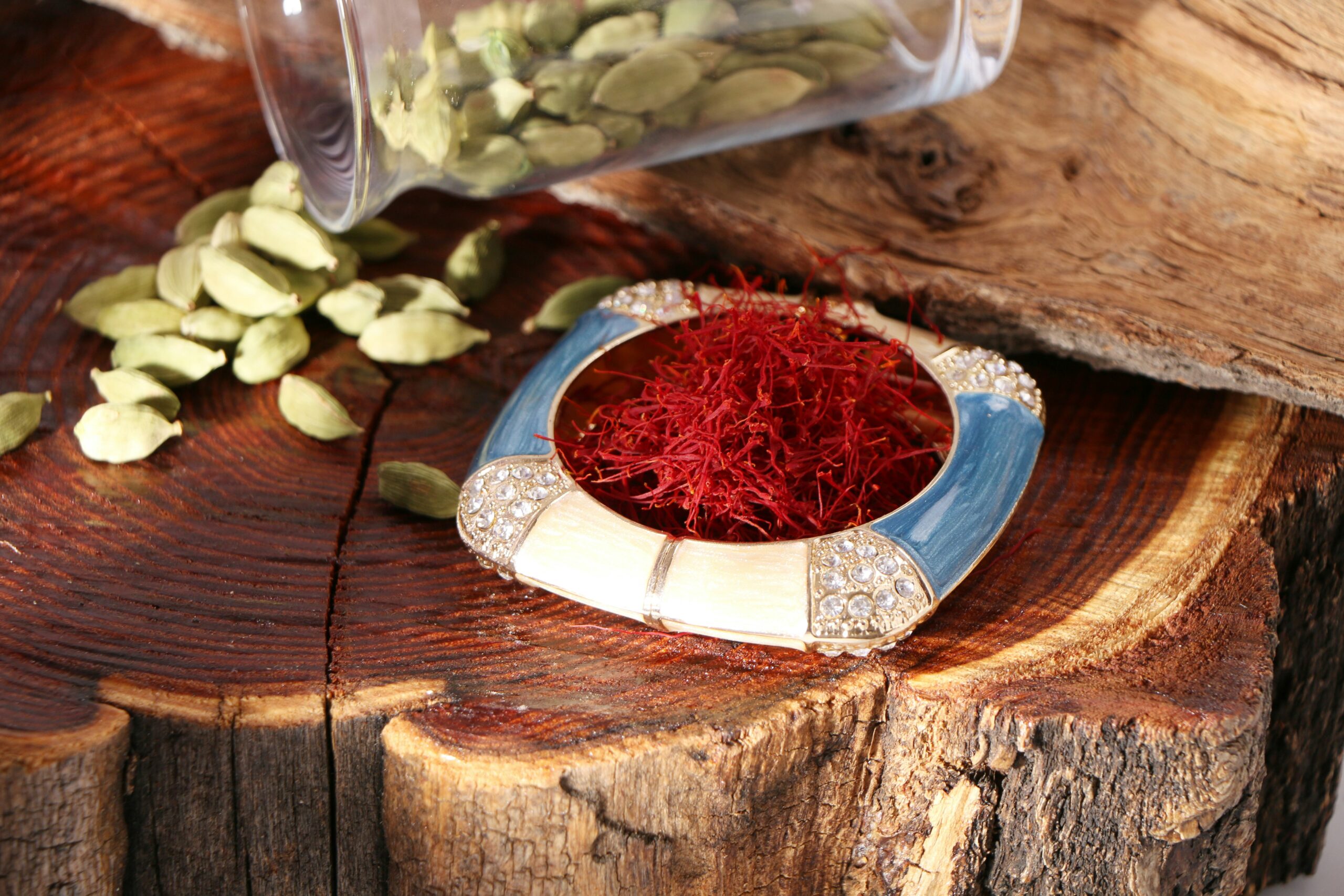Saffron is a plant known to humans for hundreds of years. In the later Mediterranean countries, it originally grew in the East and joined the Middle East. The most extensive world production extends from the Mediterranean through India. Saffron is a monocotyledonous plant belonging to the genus Crocus (approximately 90 species).
Saffron is perennial and tuberous, standing up to 30 cm tall with slender leaves. Its purple flowers are bowl-shaped. Saffron is a beautiful plant, but not only for ornamental reasons. It is also used in cooking and other purposes.
Hence, saffron growing cannot be done without human care. A saffron plantation is nothing but endless vigilance and hard work. Why, then, all these efforts? Well there, saffron is also renowned for its medical properties. Saffron is bioactive-laden and has its uniqueness in flavor and aroma. Overall, the phytochemical characteristics of saffron translate into numerous favorable effects for human health – particularly about protection against age-associated diseases, a valuable benefit that supports the use of this medicinal plant.
However, saffron is a very expensive herb because its cultivation is challenging. Moreover, many saffron flowers must be collected to get a small quantity of dried saffron. Besides, some studies have determined the toxic effects of saffron. Discover the amazing saffron!

Saffron was used in antiquity both as a culinary condiment and for its medicinal properties. Crocus sativus L.![]() is a medical plant known as the “red gold” for a reason. Saffron is derived from the dried styles of the cultivated flower. This exotic spice is available in powdered or strand form. Dried saffron is a deep orange color. It is also known to have a spicy, hot, and musky taste, making it popular in the spice food industry. Saffron, too, possesses few health benefits. Most of the effects of saffron on health have been discussed in contemporary pharmacology. Saffron has been reported to be effective for a number of diseases.
is a medical plant known as the “red gold” for a reason. Saffron is derived from the dried styles of the cultivated flower. This exotic spice is available in powdered or strand form. Dried saffron is a deep orange color. It is also known to have a spicy, hot, and musky taste, making it popular in the spice food industry. Saffron, too, possesses few health benefits. Most of the effects of saffron on health have been discussed in contemporary pharmacology. Saffron has been reported to be effective for a number of diseases.
Saffron has also been investigated for neuropsychiatric diseases in several studies. All of this research has led to positive conclusions that interchangeable saffron with effective treatment methods will reduce the incidence of depression and other conditions. Evidence indicates that saffron extracts and their constituent ingredients exert antidepressant effects mediated, at least in part, through activation of systems regulating several brain processes.
According to the research, saffron improved from a baseline score on the Beck Depression and Anxiety Scale![]() when 50 mg was used; this effect was equivalent to or higher than that of placebo treatment. The treatment of combined saffron and curcumin was additionally associated with improvement in the severity of depressive symptom scores among patients with major depressive disorder. Collected scientific data gives saffron good marks in alleviating the symptoms of depression, which may also be comparable to antidepressants. It also doesn't have the same side effect profile as pharmacotherapy.
when 50 mg was used; this effect was equivalent to or higher than that of placebo treatment. The treatment of combined saffron and curcumin was additionally associated with improvement in the severity of depressive symptom scores among patients with major depressive disorder. Collected scientific data gives saffron good marks in alleviating the symptoms of depression, which may also be comparable to antidepressants. It also doesn't have the same side effect profile as pharmacotherapy.
Impressively, saffron extracts quickly act on a variety of problems. This wonderful herb can also be used for the treatment of anxiety disorders. Research has demonstrated that saffron constituents possess anti-anxiety effects comparable to those of standard drugs. Moreover, some saffron constituents could reduce obsessive-compulsive behavior![]() . So, saffron might be beneficial for symptoms of anxiety and stress. It is an extremely promising plant-based substance that could be standardized to avoid mental conditions in the future.
. So, saffron might be beneficial for symptoms of anxiety and stress. It is an extremely promising plant-based substance that could be standardized to avoid mental conditions in the future.
Acute supplementation with some compounds isolated from saffron was also beneficial in reducing the negative symptoms of schizophrenia, as observed by a reduction in social isolation upon administration of therapeutic drugs. In addition, saffron constituents alleviated schizophrenia-induced hypermobility, stereotypy, ataxia, and memory deficits caused by the schizophrenia agents. Several published studies also suggested that saffron extracts are safe and well tolerated in patients with schizophrenia.

These also represent arguments in favor of saffron for treating age-related neurodegenerative diseases. Novartis pointed to lab studies showing that plants enhance cognition and memory among Alzheimer's disease![]() patients. Beyond that, saffron components ameliorated motor deficits and dopaminergic neuronal loss in Parkinson's disease patients
patients. Beyond that, saffron components ameliorated motor deficits and dopaminergic neuronal loss in Parkinson's disease patients![]() . This action of saffron is mainly due to this plant's strong antioxidant and anti-inflammatory properties, potentially affecting the treatment of neurodegenerative diseases.
. This action of saffron is mainly due to this plant's strong antioxidant and anti-inflammatory properties, potentially affecting the treatment of neurodegenerative diseases.
Components of saffron have been explored in studies to protect against myocardial damage![]() . Multiple studies demonstrated a cardioprotective effect of saffron in myocardial infarction via modulation of oxidative stress. Furthermore, saffron decreased the vulnerability and occurrence of life-threatening ventricular arrhythmias in ischemic models. It also protects cerebral ischemia by neuroprotection in this plant. This all attempts to demonstrate saffron as a spice positively affects cardiovascular health.
. Multiple studies demonstrated a cardioprotective effect of saffron in myocardial infarction via modulation of oxidative stress. Furthermore, saffron decreased the vulnerability and occurrence of life-threatening ventricular arrhythmias in ischemic models. It also protects cerebral ischemia by neuroprotection in this plant. This all attempts to demonstrate saffron as a spice positively affects cardiovascular health.
Saffron also confirms its antihypertensive effect, yet another advantage to consider in the beneficial trade associated with saffron and heart. Some patients with hypertension associated with cardiovascular disease could have atherosclerosis![]() as its origin. The current results showed a dose-dependent decrease in mean blood pressure by saffron extract and its constituents. Saffron may thus be beneficial for hypertensive patients. In healthy adults, saffron was also found to reduce systolic and mean arterial pressure after days of treatment. As a result, plants can be utilized to decrease hypertension and its complications like atherosclerosis.
as its origin. The current results showed a dose-dependent decrease in mean blood pressure by saffron extract and its constituents. Saffron may thus be beneficial for hypertensive patients. In healthy adults, saffron was also found to reduce systolic and mean arterial pressure after days of treatment. As a result, plants can be utilized to decrease hypertension and its complications like atherosclerosis.
Also, the hypolipidemic effect is another cardiovascular property of saffron. Research indicates that saffron reduces high levels of triglycerides, total cholesterol, and LDL cholesterol, hence its protective role against dyslipidemia. It is widely accepted as a more important risk factor in cardiovascular disease, intimately associated with the promotion of multiple steps of atherosclerosis activation. The hypolipidemic effects of plants may be partially due to fat and cholesterol malabsorption, which is partly mediated by inhibiting pancreatic lipase.

Saffron also has the property that the plant can modify insulin levels and lipid profiles. The spice's beneficial effects on insulin resistance are associated with decreased oxidative stress and propriety levels of adiponectin. Furthermore, a randomized clinical trial revealed that saffron supplementation during several months significantly decreased fasting plasma glucose concentrations in type 2 diabetic patients compared to baseline values.
So, saffron could be a potential health benefactor for diabetic patients. Nonetheless, we should be careful as antidiabetic drugs will ultimately lower blood glucose levels, and this promotes the possibility of hypoglycaemic events.
Saffron also works upon the organ of sight. Research has confirmed that the plant is helpful for retarding retinal degeneration. Significant was also the improvement in visual acuity and other essential parameters of interest with continuous administration of saffron. Hence, saffron might exert good effects on multiple eye diseases. The plant's parts have been developed as a potential therapeutic strategy in diabetes retinopathy![]() management via the control of microglial activation. In other studies, saffron extract given orally could decrease the rise of intraocular pressure and protect retinal ganglion cells from death in a glaucoma
management via the control of microglial activation. In other studies, saffron extract given orally could decrease the rise of intraocular pressure and protect retinal ganglion cells from death in a glaucoma![]() model.
model.
Nevertheless, more experimentation is needed to understand how saffron components can reduce the symptoms of glaucoma if applied directly. Saffron supplementation from diet, in general, has been shown to delay photoreceptor cell degeneration and loss of retinal function. It has also been shown to protect against vascular network disruption in the retinitis pigmentosa model.
Muscle weakness is usually regarded as a temporary or permanent decrease in the strength of your muscles and is commonly caused by immobility, muscle strain, or aging. It can also develop into chronic health problems. Given this, this review was to systematically review the current evidence regarding saffron and its effect on physical performance. In this study, saffron supplementation improved muscle strength![]() and reaction time. It also helped increase blood flow and oxygen supply to muscle tissue during exercise. Saffron also contains compounds that help lower oxidative stress and inflammation in osteoarthritis.
and reaction time. It also helped increase blood flow and oxygen supply to muscle tissue during exercise. Saffron also contains compounds that help lower oxidative stress and inflammation in osteoarthritis.

For thousands of years, saffron has been among the most useful medicinal plants in cooking. Saffron is also used in cosmetics due to its useful chemical constituents. The chemical characteristics of saffron are familiar today. The numerous active compounds found in saffron ensure that it has health benefits. Proteins and multiple sugars make up saffron. It also has some vitamins and minerals as well. We can find small quantities of B vitamins such as riboflavin![]() and thiamin
and thiamin![]() —small amounts of fiber, lipids, and minerals.
—small amounts of fiber, lipids, and minerals.
Natural antioxidants or other healthful contents are what matter in saffron. These may include carotenoids, numerous polyphenols and flavonoids, and terpenes — the percentages of which are more or less extra. Also, note the four primary and biologically active chemicals in saffron. So, without further explanation, let us present the top components of this fantastic spice.
Crocin is a carotenoid that is considered a natural dye that gives saffron its red-orange color. It is one of the most essential elements found in the plant and also an indicator of the spice's therapeutic effect. In the food and drug industries, crocin can be extracted from saffron or used as a separate source. That is why this substance can be so easily dissolved in water and thus used as a coloring additive.
Although saffron has many active ingredients, its properties are usually related to essential oils and glycosides such as crocetin. This compound is one of saffron's other coloring substances. However, crocetin is the main saffron pigment. This compound is responsible for saffron's many advantageous properties. Because it can work as an acid dye for biological coloring, crocetin is also a valuable tool for scientists.

The Saffron content of Picrocrocin, which is available in small numbers, indicates the quality of saffron; the higher this amount, the greater the quality of saffron. The active agents of saffron are the metabolites derived from complex carotenoids. These carotenoids are responsible for saffron's particular bitter-spicy flavor. The antioxidant action of saffron is also comparable to that of carotenoid-rich vegetables, which can be related to the synergistic effects of all its bioactive constituents.
The aroma is primarily due to an organic compound, safranal, produced once saffron has dried. Because of the distinct odor characteristic of a plant's dehydration, it is quickly utilized as an aroma to enhance sensory features even further. The quantity of safranal also influences the quality of saffron. The more of this stuff, the greater the health effects shown by the plant. Such a natural ingredient will be beneficial for use in various food, medical, and cosmetic functional products.
Saffron is the most precious commodity due to its uniqueness and high value. However, is it a safe product for everybody? Additional clinical studies on saffron indicate that the ingredient is somewhat of a safe herbal item. Nevertheless, research has emphasized that the plant is harmless when taking adequate therapeutic doses.
Always follow the directions on the package or leaflet when using a saffron product. Don't take more than recommended. Saffron can cause some side effects if consumed in excess. So, indicating its mild toxicity can make you sick. Depending on which parts of the plant precisely, safranal appears to be almost more poisonous than crocin. For this reason, contraindications for saffron should also be remembered.

Like any other plant, saffron can lead to allergic reactions. People can suffer from allergies, whether by contacting saffron through the skin or taking it orally. Saffron and other spices are hazardous ingredients for persons who have allergies. Spices are another overlooked food allergen, as many are powdered plants added to various dishes. As a result, it is harder to avoid the offending allergen, and in more extreme situations, an allergy can be incredibly life-threatening.
In short, pregnant women should never be consumers of untested supplements. Saffron is especially hazardous for them due to studies mentioning that the miscarriage![]() rate of pregnant patients changes depending on the high doses of the plant. This means that pregnant women should avoid high doses of saffron.
rate of pregnant patients changes depending on the high doses of the plant. This means that pregnant women should avoid high doses of saffron.
Saffron should never be used in children, either, due to the absence of studies on safe doses of the plant. To be safe, we do not advise giving children untested products. Children can be more susceptible to harmful agents, so special care should be taken.
Saffron also has the potential to react with some medications. Heavily researched herbal preparations and their potential impacts on common medications. Remember to do this with your doctor before taking supplements, particularly if you are on any meds all the time. Saffron might impact the results of medications utilized for diabetes or high blood pressure. And let it be remembered that it should not be mixed with synthetic antidepressants used during saffron preparations.